Tag archives: experiments
The museum exhibit that you inspired
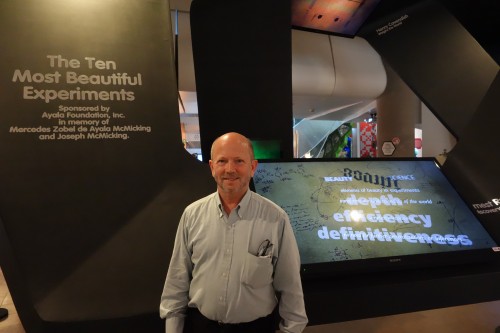
Inspired thinking – Robert P Crease in front of an exhibit at Manila’s Mind Museum that was inspired by Physics World readers.
By Robert P Crease in Singapore
It’s not often that you come across a museum exhibit based on a Physics World article. But I did on Saturday at the Mind Museum – an extraordinarily beautiful and original science museum in Taguig, on the outskirts of Manila in the Philippines.
Not only that, the exhibit is right at the entrance. You may recall that I once asked Physics World readers for their thoughts on the 10 most beautiful experiments and wrote up the results in an article in September 2002. The project turned into a book, The Prism and the Pendulum: The Ten Most Beautiful Experiments in Science, which came out the following year and which Physics World reviewed.
Maria Isabel Garcia, who was planning exhibits for the then-future Mind Museum, saw the article and book, and created an exhibit based on it, consisting of videos and explanations of each of the 10 experiments, along with a sculpture designed by the Philippine artist Daniel de la Cruz.
When waiting for 10 years is just too long
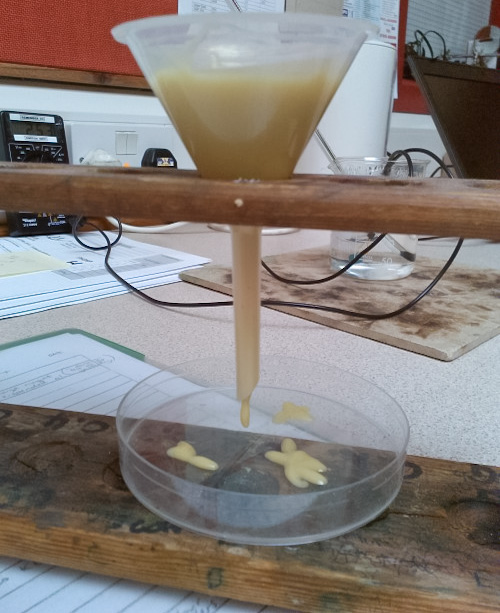
Fed up with waiting 10 years for a drip of pitch to fall? Try Silly Putty instead.
By Matin Durrani
In case you haven’t seen it yet, I do encourage you to read our feature article from the May issue of Physics World about the now-famous pitch-drop experiment at Trinity College Dublin. This simple funnel of pitch shot to fame last year after a drop from it was finally observed falling for the first time – with a video of the dripping drop having so far been viewed more than two million times on YouTube.
Although it was the first time that a drop had been seen to drip from the Dublin funnel, it’s thought that other drops would have fallen about once a decade since the apparatus was set up in 1944. Be that as it may, Trevor Cawthorne from Queen Elizabeth’s Grammar School in Horncastle, Lincolnshire, UK, e-mailed me this morning, pointing out – quite rightly – that “10 years is a long time to wait for the results of an experiment”.
View all posts by this author | View this author's profile
BOSS uses 164,000 quasars to map expanding universe
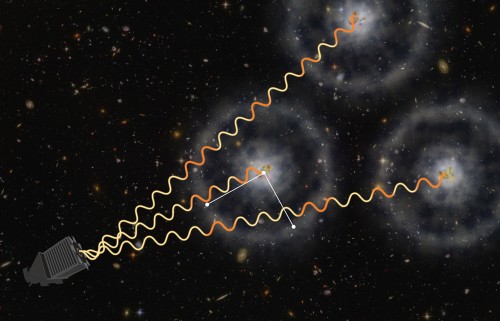
An artist’s illustration of how BOSS uses quasars to measure the distant universe. (Courtesy: Zosia Rostomian, Lawrence Berkeley National Laboratory; Andreu Font-Ribera, BOSS)
By Calla Cofield at the APS April Meeting in Savannah, Georgia
Scientists looking at data from the Baryon Oscillation Spectroscopic Survey (BOSS), the largest programme in the third Sloan Digital Sky Survey, have measured the expansion rate of the universe 10.8 billion years ago — a time prior to the onset of accelerated expansion caused by dark energy. The measurement is also the most precise measurement of a universal expansion rate ever made, with only 2% uncertainty. The results were announced at a press conference at the APS’s April meeting on Monday, at the same time that the results were posted on the arXiv preprint server.
The rate of universal expansion has changed over the course of the universe’s lifetime. It is believed to have gradually slowed down after the Big Bang, but mysteriously began accelerating again about 7 billion years ago (by rippstein). BOSS and other observatories have previously measured expansion rates going back 6 billion years.
Why axing practicals from science exams is a bad idea
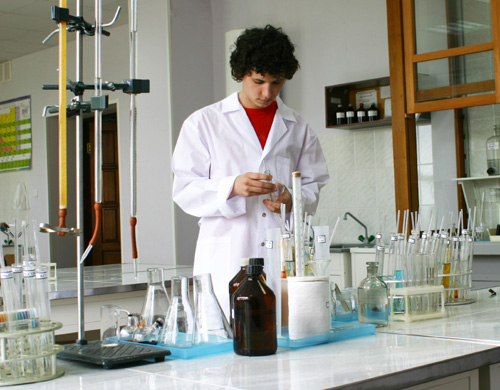
(iStock/LuVo)
By Matin Durrani
I don’t know about you, but I look back rather nostalgically on the practical exams that I took as an 18 year old as part of my A-levels in physics and chemistry. At the time, I wasn’t looking forward to them at all – they lasted three hours each and there was always the very large possibility of completely mucking up your experiment and/or dropping all your samples on the floor.
Although I’ve forgotten everything about my physics practical exam, the chemistry practical still sticks out in my mind. I remember making some needle-like crystals that, through amazing good fortune, turned out really well – certainly far better than the watery mush I’d created in my mock exams. So when I walked over to the other side of the lab to measure the temperature at which the crystals melted, they did so over a really narrow range – and presumably at the “correct” temperature too.
View all posts by this author | View this author's profile
Nobel trivia, turn your phone into a spectrometer and more
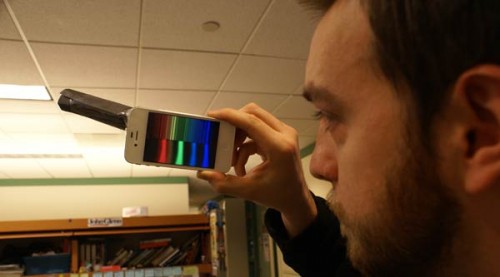
APS Outreach Specialist James Roche shows off SpectraSnapp. (Courtesy: Mike Lucibella/APS)
By Hamish Johnston and Tushna Commissariat
This was Nobel week, and physicists had two prizes to celebrate this year. Of course there was the prize for physics, which this year went to Peter Higgs and François Englert for their theoretical prediction of the Higgs boson in 1964.
Shortly after the physics-prize announcement, Englert was on the phone to Stockholm, but the Nobel officials couldn’t seem to find Higgs. Early rumours were that he had retreated to the Highlands of Scotland to avoid the media glare, but a few hours later he was photographed outside his Edinburgh home by The Scotsman newspaper.
Later, the BBC reported that Higgs was told about his Nobel win by a passer-by on an Edinburgh street, who stopped her car when she spotted the physics laureate on the pavement. “She congratulated me on the news and I said ‘Oh, what news?’,” Higgs is quoted as saying.
View all posts by this author | View this author's profile
Atlantis lifts off into history
By Tushna Commissariat
Despite gloomy weather conditions that threatened to cancel the launch altogether, NASA’s shuttle Atlantis has launched from the Kennedy Space Center. Marking the last and final flight of the Space Shuttle Programme – STS-135 – Atlantis and a four-person crew are on a 12-day mission to deliver more than 3.5 tonnes of supplies to the International Space Station (ISS). This final stock should keep the station running for a year. Although the countdown stopped briefly at 31 s before the launch, the shuttle had a “flawless” lift-off, according to NASA. It has now settled down into its preliminary orbit ahead of its rendezvous with the ISS this Sunday morning.
The image above is of the shuttle, taken shortly after the rotating service structure was rolled back yesterday at Launch Pad 39A at the Kennedy Space Centre in Florida (Credit: NASA/Bill Ingalls). Below is an image of the mission patch for this final iconic flight (Credit: NASA).

“The shuttle’s always going to be a reflection of what a great nation can do when it commits to be bold and follow through,” said astronaut Chris Ferguson, commander of the mission, from the cockpit of Atlantis minutes before the launch. “We’re completing a chapter of a journey that will never end. Let’s light this fire one more time, and witness this great nation at its best.”
Atlantis was the fourth orbiter built and had its maiden voyage on 3 October 1985. Atlantis had a number of firsts to its name – it was the first shuttle to deploy a probe to another planet, to dock to the ISS and the first with a glass cockpit! It conducted a final servicing mission to the Hubble Space Telescope in May 2009.
NASA has decided to retire its shuttle programme with this last flight because the vehicles are too costly to maintain. It now intends to contract out space transport to private companies. The hope is that this will free NASA resources to invest in a other programmes that will potentially send humans beyond the space station to the Moon, Mars and maybe even asteroids.
Atlantis is also carrying some rather unusual passengers – some simple yeast cells. The aim is to study the yeast cells as their genetic make up is remarkably similar to that of a human cell. This makes it an ideal system for studying genetic defects and understanding how these defects may manifest in human disease. In two separate experiments – conducted at the ISS – researchers will study the effect of microgravity on cell growth.
The video below has the crew of Atlantis talking about the “vibrancy of the ISS as a stepping stone for NASA’s plans for future human exploration beyond low Earth orbit”.
View all posts by this author | View this author's profile
